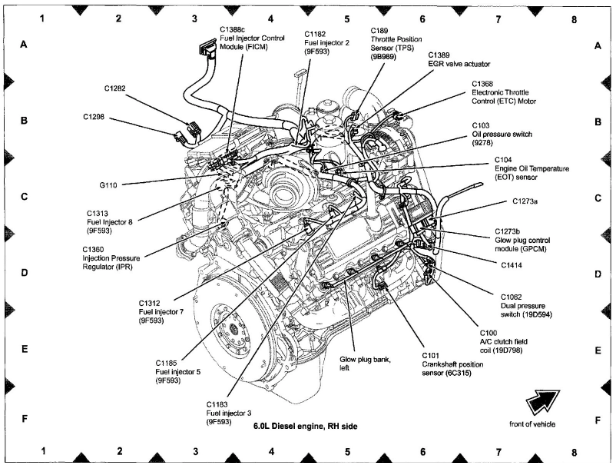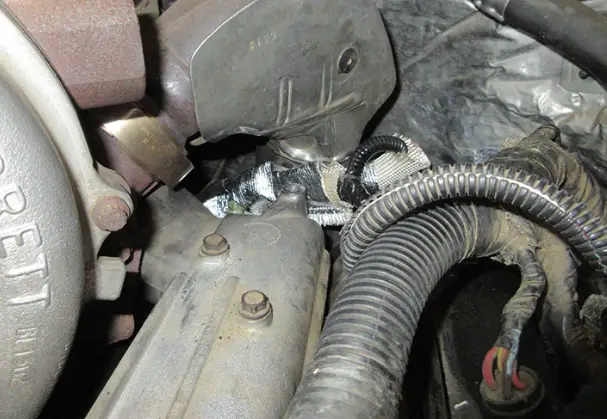Understanding the location and function of 6.0 Powerstroke sensors is paramount to addressing any issues with the engine. If a sensor fails, it can cause severe problems for your vehicle's performance and safety. It is, therefore, essential to familiarize yourself with the sensor locations on your car to best diagnose and solve any potential issues quickly and effectively.
🚀Recommended article: 6.0 Powerstroke Map Sensor
This article will provide an overview of all 6.0 Powerstroke sensor locations and their respective functions within the engine system. With this comprehensive guide, individuals can quickly locate each type of sensor which could help them more accurately identify problems with their vehicles should they arise in the future.
Where Are The 6.0 Powerstroke Sensor Locations?

The 6.0 Powerstroke vehicle offers many features for its users, including various sensors that provide information regarding the car's oil pressure, temperature, and oxygen levels. These sensors have been strategically placed across the vehicle to ensure continuous readings are taken from each component they are connected to.
Accurate readings from these sensors are integral for the PCM or ECM to guarantee efficient performance and overall good condition of your 6.0 Powerstroke vehicle. Furthermore, these sensors enable you to detect any signs of malfunction early, thus allowing timely repairs to be conducted accordingly.
1. Intake Manifold Absolute Pressure (MAP) Sensor
The 6.0 Powerstroke engine vehicle has an intake manifold absolute sensor that monitors the pressure and vacuum within its intake. The device, located near the input of various areas, is connected to the information via a vacuum pipe. Its primary function is to measure the pressure and relay data back to the powertrain or engine control module for optimal performance when accelerating with an open throttle plate. By keeping track of these readings, the MAP sensor helps ensure that your car runs efficiently without interference from outside sources such as debris or dirt buildup on parts in your engine bay.
2. Engine Coolant Temperature (ECT) Sensor
The engine coolant temperature sensor on a 6.0 Powerstroke vehicle is located near the thermostat housing or cylinder thermostat. This critical component can be accessed by removing the airbox under your hood. The sensor's primary function is to alert the PCM of any changes in temperature within the cooling system and ensure that the idle air control (IAC) position remains consistent. When this sensor fails, it can lead to issues such as overheating and severe mechanical problems, which should not be taken lightly.
3. Throttle Position (TP) Sensor
The throttle position sensor is essential to any vehicle, as it monitors air intake levels. It is attached to the car's throttle body and the butterfly spindle or engine shaft. On a 6.0 Powerstroke, you will find this sensor between the intake manifold and the air cleaner.
This device must function properly to ensure accurate measurements of how open the throttle valve is at all times. This data allows the PCM (Powertrain Control Module) to determine how much air enters your engine, affecting how well your car accelerates when driven. Therefore, if a problem with this sensor arises, such as it going bad or malfunctioning somehow, it could lead to significant issues affecting acceleration performance due to incorrect readings taken by your car's system.
4. Vehicle Speed Sensor (VSS)
The vehicle speed sensor plays a vital role in monitoring the rotational speed of the transmission system. It is typically mounted on the vehicle transmission, between the wheel and axle, ensuring it can accurately measure speed. The sensor then records this data into an analog signal sent to your car’s Electronic Control Unit (ECU). This allows for precise control over how quickly your engine runs at any given time.
If something goes wrong with the vehicle's speed sensor, however, it may send incorrect information to ECU, resulting in errant readings or inaccurate calculations when you're driving. To ensure smooth operation and accurate results from your 6.0 Powerstroke engine, check on its performance regularly and replace components as needed!
5. Fuel Rail Pressure (FRP) Sensor
The 6.0 Powerstroke engine contains a vital component known as the Fuel Rail Pressure (FRP) Sensor. This sensor is located in the middle of the fuel rail system and can be found by opening the vehicle’s hood to discover it near the intake manifold. The FRP Sensor measures and sends information about fuel pressure within the fuel rail system to your vehicle’s PCM or ECU. If this sensor fails, your car's PCM will not be able to determine how much fuel is needed for optimal performance, resulting in poor fuel economy and weak acceleration from your engine.
6. Oil Temperature Sensor
In a vehicle powered by a 6.0 Powerstroke, the oil temperature sensor can be found under the hood. More specifically, it is mounted on the engine cylinder head or block. The primary purpose of this particular sensor is to measure and monitor the oil temperature in your car's engine. This data is then sent to the PCM (Powertrain Control Module) for further analysis and action.
Furthermore, with the help of such information from this sensor, you will better understand the heat levels generated by your Powerstroke 6.0 engine so that appropriate measures may be taken to cool it down when necessary. Therefore, your OTS (Oil Temperature Sensor) must work as intended if you want reliable monitoring of your car's engine temperatures at all times.
👀Look at this: P0603 6.0 Powerstroke
7. Camshaft Position Sensor
It is essential to correctly locate the camshaft position sensor to diagnose a potential vehicle issue. The location of this component may be found behind the power steering pump, underneath your car, and on top of the cylinder.
A camshaft position sensor provides information about cylinder events to the PCM (Powertrain Control Module). When this part malfunctions, it can lead to issues like poor fuel economy or idle engine problems - so experts advise against continuing to drive a car with such an issue.
8. Injector Control Pressure (ICP) Sensor
The injector control pressure sensor plays a vital role in the functioning of most engines, including Powerstroke 6.0. It is located on the driver's side injector pump or fuel rail and primarily measures oil-feeding pressure in the injector. If there are any significant issues with this sensor, it can lead to engine idling, stalling, and misfiring problems.
In some cases, this sensor may leak through its pigtail connector, which will require a replacement of both the pigtail and itself. This should be done as soon as possible to ensure that the engine functions appropriately again without any interruptions.
Why Should You Know Sensor Locations?
No matter what vehicle you decide to buy, you may experience some issues as the day progresses. Fortunately, if your car is a Powerstroke 6.0 model, its sensors can help ensure that all car components function correctly by monitoring various aspects.
The different types of sensors on this particular make and model can provide an efficient and smooth driving experience. However, there may come a time when these sensors need to be checked or replaced due to malfunctioning. Knowing where they are located can enable quicker diagnosis and repair; failing that, an OBD2 scanner will provide diagnostic trouble codes which indicate any sensor-related issues.
🚨You may be interested in: P2262 6.0 Powerstroke
Final Words
Being aware of the 6.0 Powerstroke sensor locations is essential as it enables one to address any issues that may arise with them quickly. By diagnosing and understanding which components are connected to a particular sensor, an individual can swiftly resolve the issue before significant damage occurs.
This knowledge helps one detect problems before they become too severe, saving time and money in the long run. Therefore, learning about these sensors' locations is essential for anyone who wants their vehicle's onboard diagnostic system to remain in optimal condition.
Was this page helpful?


More important content about Tips and Advice
Porsche Cayenne Years To Avoid
Subaru Legacy Years To Avoid - 5 Worst Years
Pt Cruiser Years To Avoid
Use 5w30 instead of 0w20 - Advantages and Disadvantages
Tractor Dashboard Symbols And Meanings
Tips and Advice
Subaru Legacy Years To Avoid - 5 Worst Years
Pt Cruiser Years To Avoid
Use 5w30 instead of 0w20 - Advantages and Disadvantages
Tractor Dashboard Symbols And Meanings
Suzuki Sx4 Years To Avoid - 5 Worst Years
Cummins ISX Years To Avoid and Why